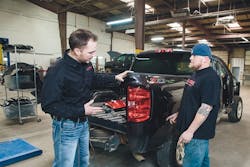SHOP STATS: Jeremiah's CARSTAR Collision and Painting Location: Oklahoma City Operator: Jeremiah Graham Average Monthly Car Count: 55 Staff Size: 11 Shop Size: 19,000 sq ft Annual Revenue: $1.6 million
Training. Benefits. Equipment. Time. Hiring a new employee is a huge investment, both financially and emotionally. That’s why Jeremiah Graham, owner of Jeremiah’s CARSTAR Collision and Painting of Oklahoma City, makes sure he hires employees that are worth that investment.
“I’ve had a lot of silver-tongue applicants,” Graham says. “A lot of people that were great at interviewing but didn’t live up to what they said they could do.”
Graham doesn’t want to come off as skeptical, but when you’ve seen one too many employees embellish their skills or not blend in with the culture of the shop, it’s hard not to be wary during an interview. That’s why, since opening his shop in 2013, Graham has implemented a strict 90-day probationary period for his new hires.
Graham says it’s a lot of work to set up a new employee. Beyond the significant time and financial investment, small things like getting them set up with all of the passwords and making sure they’re hooked up with all of the company’s benefits, can quickly eat up time.
The probationary period is not just for Graham’s benefit. The time is also meant to be a time for the employee to figure out if it’s a good fit. And it’s resulted in significantly less turnover at the shop and fewer instances of bad hires.
The Backstory
Graham has been in the collision repair business for 18 years—roughly half of his life. In January of 2013, Graham found out there was a Maaco shop whose owners had retired and were going to shut the business down. Graham decided to purchase the shop’s assets, take over and join the CARSTAR network.
The Problem
Graham had some hesitation about the staff when he came on board. He had a different vision for where he wanted to take the shop and was planning on making a lot of changes. One of the changes he planned on making was a switch in the pay structure to a flat rate system, a choice he felt might not go over well with everyone. However, with it being so soon after the holidays (he officially took over on New Year’s Eve) Graham had a hard time with the idea of letting people go. Pair that with the fact that he wasn’t sure how long it would take him to hire new staff, Graham made the decision to keep the existing employees. He informed the team that they would all be keeping their jobs.
“I was trying to make a smooth transition,” Graham says.
It quickly became clear that the staff was not on board with Graham’s vision. Of the 14-person team he inherited, only one employee still works for Graham.
The Solution
With zero human resources experience, Graham took a cue from a shop owner he previously worked for and decided that, moving forward, he would implement a 90-day probationary period for his new hires. He decided against having the staff he inherited do this, although he did have each of them reapply for his or her position.
“The state of Oklahoma is a right-to-work state, so we can fire without cause,” Graham says. “I’m not doing it because I feel like I need to cover my butt, I’m doing it as more of an agreement to take the time to see if it’s a good fit.”
“I think by doing this, you communicate to the candidate that you’re looking for more than someone that just wants a job,” Graham adds.
Graham says he does this with all of his staff, but he tends to be more strict about it with the high-turnover positions, like technicians. During the 90-day probationary period, the candidates do not have access to any of the ancillary benefits that full-time employees have or are sent to any training, but other than that, they are treated just as a regular employee would be. The probationary candidate works normal hours and is paid the same, Graham says.
The probationary period is outlined in the employee handbook, which the potential employee signs before being brought on board. Graham landed on 90 days because he felt it was a good amount of time to really get to know what the candidate is able to do and how he or she fits in with the shop culture.
“It’s hard to test out what skills a candidate has,” Graham says. “One way to do it is to watch and see what they do.”
During the 90 days, Graham will observe the candidate as a sort of on-the-job skills testing. During the repair, Graham watches the candidate’s process and after, checks the repair to see if it’s been performed correctly. Often, the person may not be familiar with a process or a tool, so Graham will do training on the repair with the candidate and then observe how he or she does on their own.
This time is also a way for Graham to assess whether or not the person is a good fit for the culture of the shop, which is something that you can’t tell by reading a resume or conducting a single interview.
“You can tell a lot just by walking around,” Graham says.
Graham also has key employees whose judgement he trusts weigh in on whether or not the person seems to be fitting in. For Graham, his culture and what works is always changing, depending on the team he’s got, so it’s important to get feedback.
Going one step further than observing the interactions between the current staff and potential hire, Graham has also issued anonymous surveys for his staff to fill out in order to share their opinions on the new person before he or she is brought on full time. The survey has the staff rate the candidate on a scale of 1–10 on questions that are meant to decide whether or not it’s a good fit and if he or she has the skills and drive necessary to work at the shop.
The staff is not the only one that has to think it’s a good fit. One of the biggest reasons that Graham decided to do this was to make sure that the candidate felt it was right, instead of hiring someone who is going to end up changing his or her mind about the job right away.
Graham has immediately terminated some people and given warnings to others. Those are dealt with on a case-by-case basis. Once the 90 days is up, Graham makes his final decision on whether or not to offer employment and then he or she will have access to benefits the company offers.
There are no formal meetings where Graham pulls the candidate into the office, but he does make sure to check in whenever he can to get a feel for what’s going on. Many of these “meetings” occur on the shop floor.
The Aftermath
Graham says that the employees that he’s hired on after the 90-day probationary period stay at least six months and those that have left have done so due to external reasons, such as a relocation, rather than an issue with the shop.
In the five years Graham has done this, he has had 19 people either decide it wasn’t for them or terminated before the 90 days was up.
“The process has a way of weeding people out,” Graham says.
Graham says that it’s usually very clear on both sides that it’s not going to be a good fit.
Seventeen people have made it past the 90 days and were offered full-time employment.
The Takeaway
Graham says that the probationary period has helped him let go of people easier. In the beginning, he held on to people longer. Now that he’s been doing it for a while, he knows what to look for.
“I’ve found that the first three months is critical to finding people that will work out,” Graham says.
About the Author

